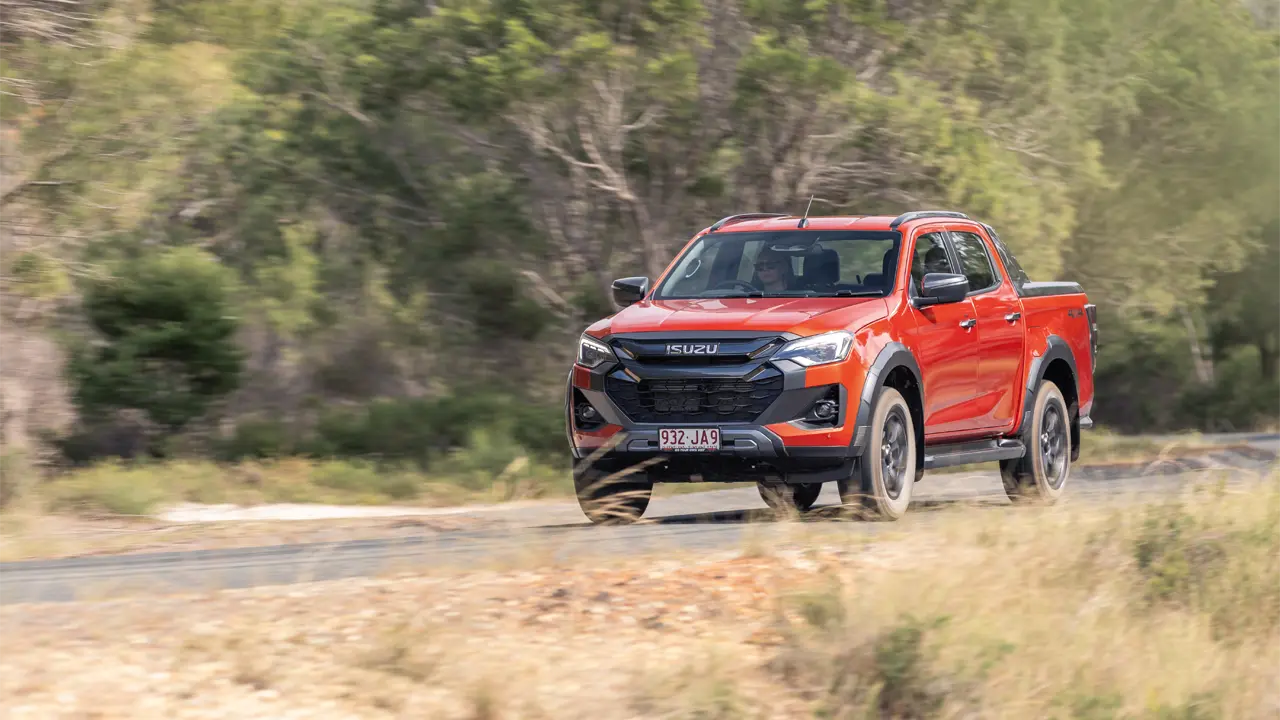The new Isuzu D-Max aims higher with greater comfort.
Story Bruce McMahon Photo Isuzu
Utes remain big business, as they are logical transport for a host of Australians, from farmers to fisherfolk to families. Four-wheel-drive, dual-cab utilities in particular find favour across the automotive landscape, even while some rarely see a dirt road. The attraction lies in the versatility of a passenger vehicle with load-carrying capacity, towing ability plus off-road capability. There’s a touch of blue-singlet macho, too, as evidenced by bold front styles and brash body colour options for high-end versions.
Among the more popular is Isuzu’s D-Max, one of the well-respected originals. It was once more the worker ute, but in recent seasons has added to its repertoire with a range of up-market, more refined machines to attract a wider crowd. In 2024 a facelifted D-Max further added to its charms, with fresh technology and upgraded safety features.
In what’s been tagged “the most comprehensive update” since the D-Max debuted in 2008, there are now 25 two- and four-wheel-drive variants, with 1.9L and 3L diesel engine options, single cab, space cab and crew cab bodies. All have a more aggressive nose and grille plus interior updates, and there’s a softer rear suspension for the LS-M dual cab and the X-Rider.
Flagship of Isuzu’s D-Max mob remains the X-Terrain, a 4-door ute with the lot, from leather-accented upholstery with red stitching to remote engine start and roller tonneau cover. For all its extras (and premium price around $70,000), the flashed-up X-Terrain retains the underpinnings of the rest of the fleet. There’s the valued 140kW, 450Nm turbocharged diesel, a 6-speed automatic transmission (no manual gearbox at this end of the paddock), 4WD, 2-speed transfer case, lockable rear differential and 240mm of ground clearance. Towing capacity is 3.5 tonne.
Steering, handling and ride comfort are good under all manner of road conditions. Even if shaded a touch by the likes of the Ford Ranger and the latest Mitsubishi Triton, there is confidence and a welcome directness to the D-Max’s on-road manners.
Off-road, the Isuzu is a well-respected performer. Decent ground clearance and wading depth, dual range 4WD plus the addition of rough terrain mode – an electronic traction control system that brakes slipping wheels to transfer torque to wheels with better grip – are complemented by that robust drive train and engine torque that arrives at an early 1600rpm. First gear, low 4WD is perhaps a little quick in some situations, yet this remains a very competent machine for heading into rough country.
On or off the bitumen, the gearbox and 3L engine (with a 1.9L option on some models) are rarely found wanting. Average fuel consumption with a light payload should come in around 9–10L/100km.
Driver and front seat passenger have good head and shoulder room, although the driver’s footrest is a tad small for a size 10. Fit and finish are good, there are welcome knobs for volume and tune below the infotainment touch screen, and there are new, more readable, typefaces for the busy instrument cluster.
Among the standard safety and convenience features for 2024 models is Isuzu’s intelligent driver assistance system, including autonomous emergency braking, front collision warning, trailer sway control and blind spot monitoring. Upgraded gear includes the tyre pressure monitoring system and, most welcome of all, a more subtle lane-keeping monitor that doesn’t squawk loudly or tug hard at the steering wheel if it spots a white line. The infotainment system boasts wireless Apple CarPlay and Android Auto, digital radio, satellite navigation plus inclinometer and 4WD mode displays. It’s a comfortable, workmanlike cabin with solid basics from entry-level utes and up.
Added features as D-Max prices rise include upholstery upgrades, heated front seats, tub liners, floor carpets and a tow hitch receiver. The top-of-the-range X-Terrain is loaded with the lot, the likes of mudguard flares, an aero sports bar and roller tonneau cover. Here the Isuzu loses some utility – there are only 2 tie-down spots at the rear of the tub, the ‘sports bar’ and extended rails make tub access more difficult, the storage bin for the tonneau takes up cargo space and makes it harder to secure a tall load, and the closed tonneau is too low to accommodate upright jerry cans.
The Isuzu D-Max is a good ute with top-class fundamentals. It doesn’t always need a bunch of extras to show its class.
This story excerpt is from Issue #158
Outback Magazine: December/January 2025









